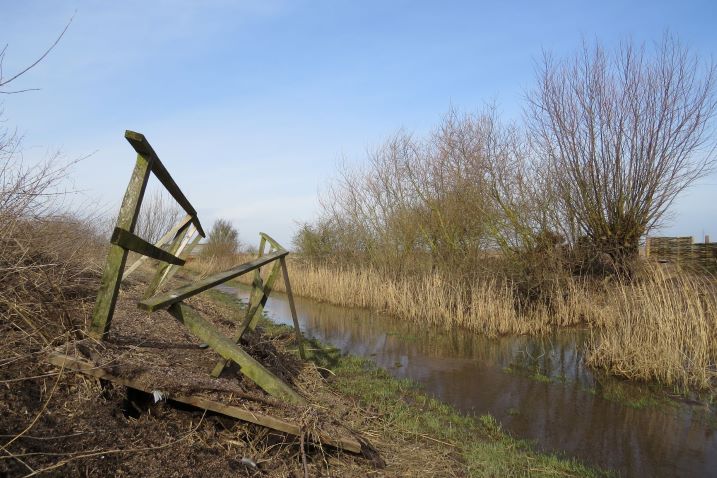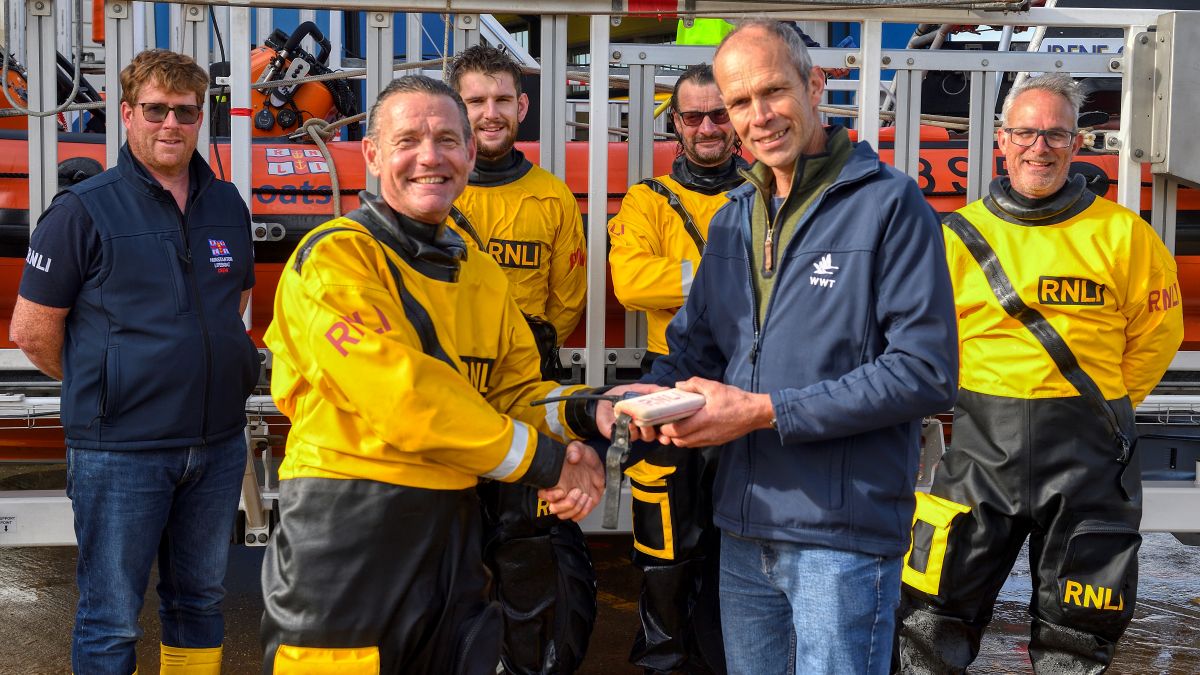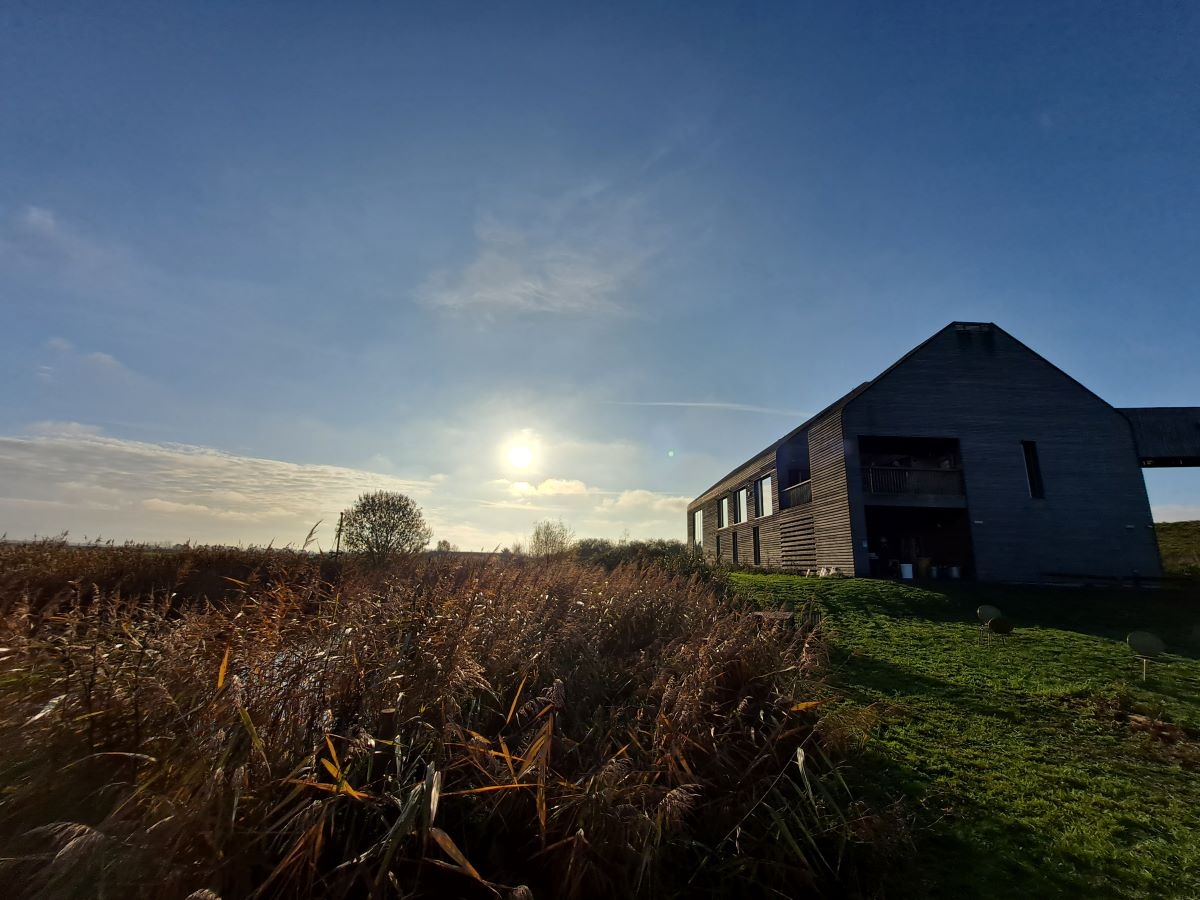Spring wetland management
Each spring the final preparations across our wetland habitat can take place ahead of breeding season. But the flooding on the Ouse Washes adds extra tasks for the team and mean this part will be unavailable to birds for a little while longer.

Each spring the final preparations across our wetland habitat can take place ahead of breeding season. But the flooding on the Ouse Washes adds extra tasks for the team and mean this part of the reserve will be unavailable to birds for a little while longer.
 Debris from floods on ramp to Nelson-Lyle hide
Debris from floods on ramp to Nelson-Lyle hide
As water levels drop away the wetlands below are revealed, along with the destruction and debris left from another winter of high flooding. When levels remain high for long spells, stormy conditions cause waves to erode banks and footpaths. The height of the water can dislodge gates, screens and bridges, and as the water spreads across the grassland it slows from the fast flow of the river resulting in deposits of silt across the washes. It is like the reserve has been put in a giant washing machine, with everything jumbled up afterwards.
 Hetty's screen - the water has forced the middle planks free
Hetty's screen - the water has forced the middle planks free
One of the few benefits of deep flooding is that the system of rivers, sluices and drains are scoured of built-up silt and the next winter’s flood waters can more quickly flow out to sea. But too many winters with these conditions are have an impact on the birds, plants and invertebrates (read our recent blog on flooding across the Ouse Washes). The downside to so much water still covering the reserve is that if we get a quick change from cold-wintry conditions, to warmer spring-like conditions the ground-nesting birds start prospecting before the habitat is ready. The 1,300 acres which could be available is reduced to 300 acres of Lady Fen, which sites outside the Ouse Washes.
 View from Reedbed hide towards the summer walk
View from Reedbed hide towards the summer walk
February 2021 saw water levels drop away rapidly for just this reason. The tidal flow of the Hundred Foot Drain allowed for water to exit the washes at Welmore sluice – these are gravity operated, so higher water levels on the ‘inside’ of the Washes than on the ‘outside’ river allow for the gates to be pushed open. When the water levels differ greatly in height, water can flow from the washes with each outgoing tide. But when the levels become the same height, the sluices remain shut and pumps are used to get remaining water off the grassland to make it available for the birds.
 Welmore sluice at sunset
Welmore sluice at sunset
Whilst this process is going on we are able to get around the site and assess the work that is needed to get Welney open again. Many of our visitor facilities are on the higher areas of the reserve and so are the first to be revealed. Our team of staff and volunteers have many hours ahead of them clearing footpaths, removing debris and fixing structures ready for visitors.
 Boardwalk to Reedbed hide
Boardwalk to Reedbed hide
By the time we have completed most of the urgent works, access is then possible to some of the washes. Repairs to cattle pens and gates for livestock become a priority ahead of the herds returning for summer.
 Cattle pen fencing
Cattle pen fencing
As water levels continue to drop, we then need to retain water in the network of ditches, pools and scrapes to make it last as long as possible through the spring. Maintaining just the right amount of water across the site is a huge task to ensure there is enough for birds to feed, drink and preen. The reserve is a vital resource for species like green sandpiper, ruff and greenshank passing through on migration, as well as those that are staying here to breed.
 Wet areas on the washes
Wet areas on the washes
The remaining water is maintained in a mosaic of smaller pools in the summer, the reserve becomes a productive breeding ground for water birds. Rich in food and nesting sites, the reserve attracts many species, including avocets, black-tailed godwits, redshank and snipe.
 Snipe bill marks from feeding in the mud
Snipe bill marks from feeding in the mud
Keeping the muddy areas just the right texture is a fine balance, we’re after the consistency of chocolate cake. Long-billed species like snipe, black-tailed godwit and redshank probe into the soft ground to feed. We need to keep these areas available for many weeks as the adults will need to continue to feed well during the nesting period and then it will be the turn of the chicks.
If we need to top the water levels up because the spring is getting too dry, we are able to do so from the River Delph. Three sluices in the riverbank can be opened to allow water to flow into the main ditch where it can then spread out through hundreds of pipes into the network of internal ditches across the site.
It is only when out on the reserve you appreciate the ditches and banks that criss-cross the wetlands, these help us control the movement of water. These waterways are ‘slubbed’ out on rotation in the autumn to keep them open for the many species of aquatic plants found on the Ouse Washes. Many species of invertebrate can also be found in, along and around the channels and they provide a natural boundary to the washes to keep herds of cattle where grazing is needed.
 One of the many ditches across the reserve
One of the many ditches across the reserve
Our centres may be closed, but our work to manage them continues
On top of this, we have so much other work to do with the climate emergency, threats to biodiversity and the future of many beloved species hanging in the balance.
Our income is being squeezed. If you can, please make a donation to our emergency appeal today so we can continue to protect, restore and conserve our wetlands and their wildlife.



